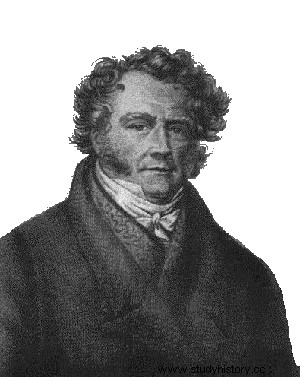Eugene-Francois Vidocq , born July 24, 1775 in Arras at 222, rue du Miroir-de-Venise and died May 11, 1857 in Paris, 2 rue Saint-Pierre-Popincourt (currently 82 rue Amelot), was a French adventurer and detective.

Son of a baker, François Vidocq committed various thefts during his childhood . His large size (at 12, he is a man) makes the job easy for him. At the age of 16, he left Arras after stealing from his parents and joined the revolutionary army. He then fought at Valmy and Jemappes then deserted the army. He was expelled from there in 1793. He then pursued an adventurous life as a thief and crook between Paris and the north of France.
The Prison
On December 27, 1796, he was sentenced by the criminal court of Douai to eight years of hard labor for "forgery in public and authentic writings". In Bicêtre, where he was introduced to savate by Jean Goupil, he was incorporated into the chain of Brest, a group of convicts destined for the penal colony of this port. The trip, particularly trying, lasts twenty-four days.
Vidocq took the opportunity to attempt a first escape in the forest of Compiègne. This first failure does not discourage him. The chain of convicts reached Brest on 24 Nivôse Year VI (January 13, 1798). The chain stops at the entrance to Brest at the Pontanézen hospital, where the convicts are transferred. Vidocq again tries to slip away from his goalkeepers, but he sprains both feet trying to jump the perimeter wall.
Three weeks later, he entered prison. The prison register describes him as follows:“22 years old, height of 5 feet, 2 inches, 6 lines; light brown hair, eyebrows, beard of the same; budded oval face; gray eyes, big nose; medium mouth, round and forked chin, low forehead, having a scar on the upper lip on the right side; pierced ears. »
Eight days after his arrival, he managed to get some sailor's clothes which he hid in the arsenal where he worked. Having managed to change (Vidocq is a real transformist) surreptitiously, he left Brest without being worried.
Arrested again in 1799, this time he was sent to the prison of Toulon, from where he escaped once again, on March 6, 1800. In this way, he acquired unequaled respect and notoriety among people in the milieu.
Safety
In 1806 he offered his services as an informant to the Paris police.
In 1811 the prefect placed him at the head of the Sûreté Brigade, a police service whose members were former convicts and whose role was to infiltrate the “milieu”. An excellent physiognomist, he spotted wonderfully, even made up, anyone he had previously stared at. He himself excels in the art of disguise.
His many successes and his unorthodox methods bring him as many admirers as detractors. His men claim three times more captures than the classic police between 1811 and 1827. The latter then try by any means to destabilize Vidocq.
Popular image of the episode of the forest of Sénart
His enemies are in the underworld but also in power. Twice, his superiors made him resign. Several people arrested by Vidocq accuse him of having staged the blows in order to then arrest those who took part in them and, in this way, prove his effectiveness in the fight against crime. The court did not uphold these allegations. Vidocq is removed from office and replaced by Allard. Urbanization, the constitution of the working classes that we observe at the end of the restoration transfers the fear of crime from rural areas to the City.
The Trade Information Bureau
In 1827, Vidocq resigned from his position as head of the Sûreté. He moved to Saint-Mandé, near Paris, and created a small paper factory. He invented tamper-proof paper. In 1828, he published Memoirs which met with great success, and which notably inspired Honoré de Balzac with his character of Vautrin. Ruined by his paper factory business, he held the position of chief of security again for seven months in 1832, then left the public service definitively and in 1833 founded the Commerce Intelligence Bureau, the first detective agency which provides merchants, for a fee, with intelligence and economic surveillance services, as well as information on fickle spouses.
Aged 82, François Vidocq died in Paris as a result of cholera on May 11, 1857, at 82 rue Amelot (formerly 2 rue Saint-Pierre-Popincourt). His burial place is now unknown. A rumor said he was buried with his wife in Saint-Mandé, however the municipal services of the city refuted this information. We know, however, that the funeral ceremony was celebrated at the Saint-Denys-du-Saint-Sacrement church in Paris in the third arrondissement.
